Among the collection of worrisome symptoms, a dry nose is perhaps the most misunderstood of them all. If you are like most of us and immediately jump on Google search looking for possible causes, symptoms, and treatment, then this article will be your saving grace.
I have googled countless things regarding my dog’s health, and more often than not, it takes several hours to find some viable explanation. Many of the causes include potentially fatal diseases that are simply not possible on a healthy, regularly vet-checked, and vaccinated dog.
If only there were articles like this one when I was searching. Anyways, let us cut to the chase. Everything I learned about crusty dog noses over the years will be in this short read. A dry nose is not the end of the world.
My Dog’s Dry Nose Is Crusty, This Blows
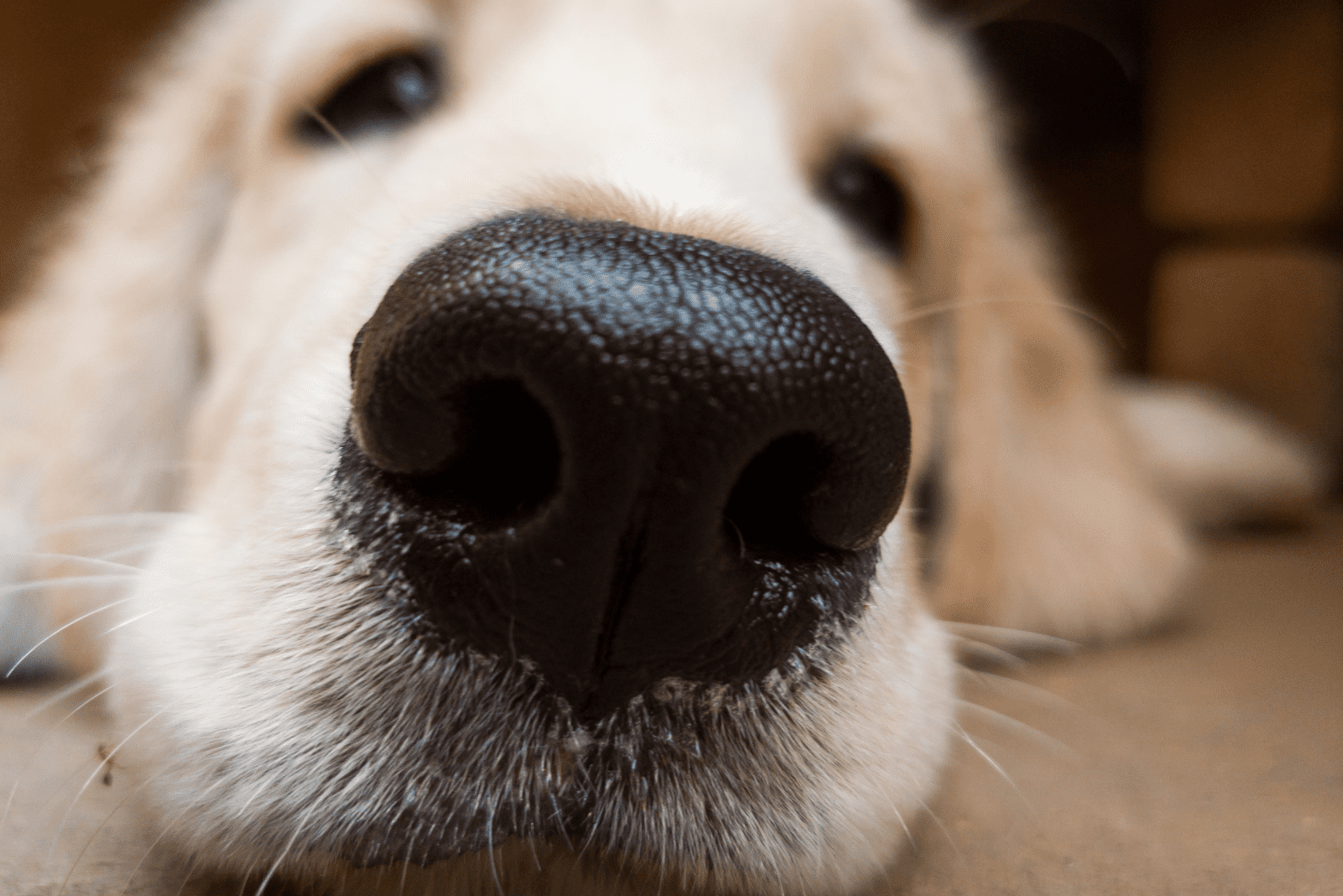
Hey, I have been there. You noticed something odd on your dog’s nose, or it started behaving unusually. Naturally, we first resort to becoming upset, followed by research on the matter that ends up in completely losing our minds over it.
A dog’s nose is a conduit that helps them explore the world surrounding it, so it is perhaps the most used tool in the dog’s arsenal. The primary role, of course, is breathing.
However, it is not that well-known that dogs sweat through the skin on the nose and paw pads, which helps them control body temperature. The “sticky factor” of a wet nose is also important for scent analysis too.
Most dogs with a dry nose have no fatal condition, and the causes are so easily explained that you could feel silly for overreacting. The goal here is to make sure there is no overreaction if you notice a crusty dog nose.
What Is A Crusty Nose?
I feel that we should address the elephant in the room first, and that is what qualifies as a crusty nose. You already know that the black skin (usually) that covers the largest portion of a dog’s nose, also called rhinarium is textured and wet most of the time.
Small crinkles and ridges can be found on the middle and sides, and together with the tiny circular dimples most noticeable on the front side of the nose, it comprises a nose print.
Just like human fingerprints, the unique position of every one of these elements creates a pattern unique to every individual dog. While we cannot see microscopic changes to the pattern, we certainly can notice when the mainly smooth feeling of the nose tip is compromised.
A crusty nose will have deep grooves that visibly compromise the uniformity of the otherwise continuous skin on the nose. I always think of dry soil that has widening cracks in it after being exposed to the sun for too long.
If the grooves are clearly visible, then it means germs can enter quite easily. The crusting occurs once particles of food, bacteria, viruses, or fungi enter these cracks and settle for a long picnic where the deeper layers of the skin are the main course.
The crust is similar to scabs — it looks crumbly, but you cannot brush it away. Dogs that continuously paw their nose can create multiple layers of scar tissue that can significantly change the rhinarium anatomy.
The List Of Causes From Harmless To Heartless
1. Your Dog Is So Hungry, It Inhales Food
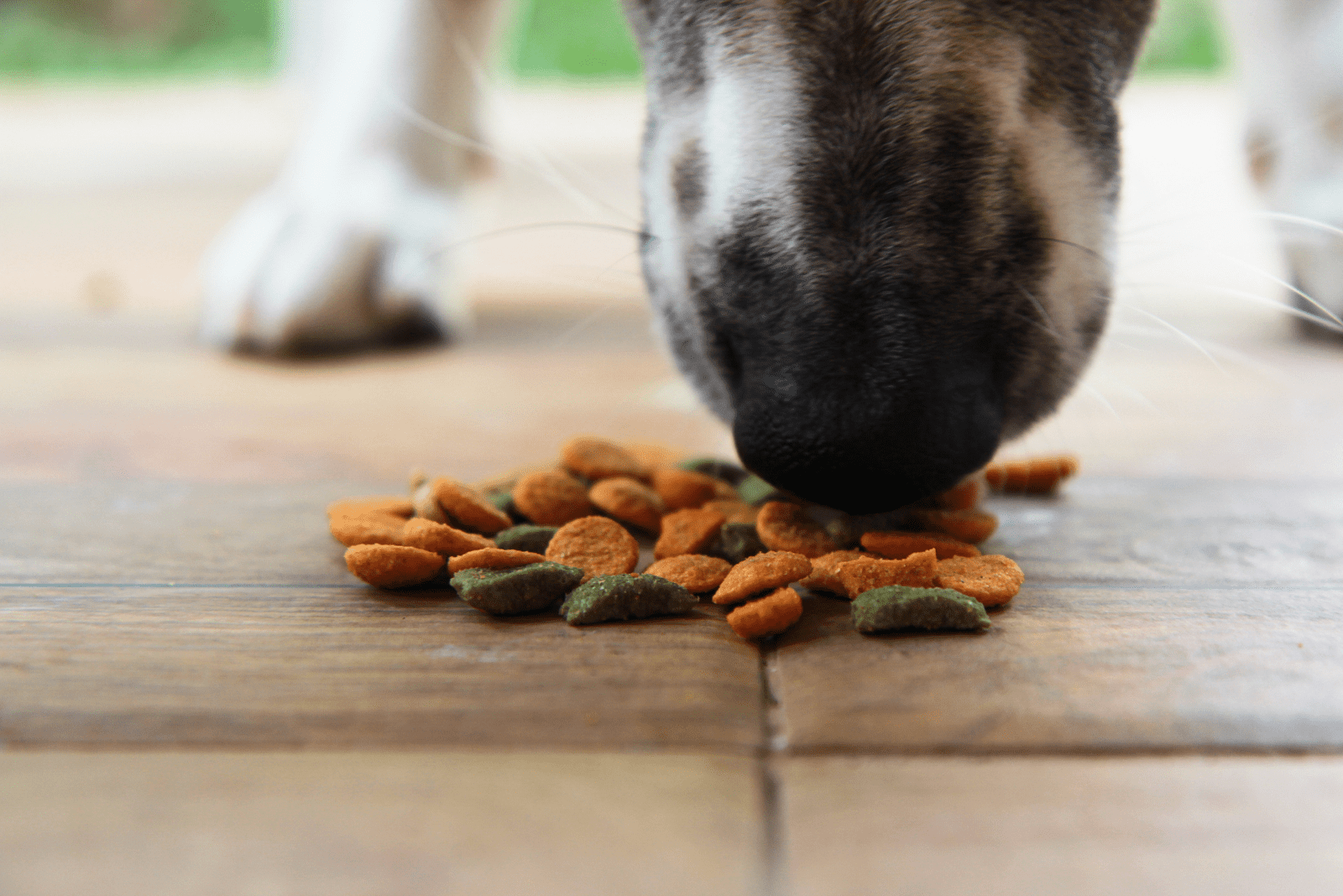
Yeah, I am dead serious. My dog’s nose is like a whirlpool. He eats most of the food with his mouth, but a small amount gets on his nose too. Canine noses enable them to breathe in and out at the same time. We, humans, are too fancy for that and can do only one thing at a time.
The majority of dogs like to eat their food quickly so that they can continue with their hectic schedule. If you have a slow-eating bowl, that is a great way to teach them to enjoy the meal more slowly.
Slow or not, their nose sniffs the food while eating and sticking the tip of the nose as deep as caninely possible, some of it ends up getting stuck to the skin.
The sense of smell usually helps determine what food is safe or more nutritive than others (or simply tastier to them) and sniffing while eating is an important part of stimulating the digestive process.
A wet nose with food on it is fertile ground for bacteria, so thickening of the skin and scabs are not uncommon if the nose is not cleaned properly. Simply wiping or washing the food off of the nose will be enough to prevent that.
Pups’ noses are usually less clean than adult dogs’ due to their lack of hygiene habits, so make sure to check and clean the nose after each meal if necessary.
2. A Little Sunscreen Goes A Long Way
If you live in a dry, sunny area, the heat of sun rays can dry out the dog’s nose, causing cracks in the skin that lead to a crusty nose. If your dog has a light-colored nose, then it is even more at risk from sunburn.
Read Also: A White Spot On Dog’s Nose Requires Shampoo And A Hose
Keeping the dryness at bay will be easy if you provide sufficient hydration and shade for your dog. Never leave your dog out in the sun for too long, especially if there is a lot of dust in your area.
Moisturizing your dog’s nose is an easy task — you simply use some vet-approved sunscreen or nose balm or rub in some coconut oil once a week. Five minutes of it soaking the dog’s nose is enough to “feed” the skin. Wash off the excess oil afterward.
Make sure your dog is not allergic to any natural ingredients you are planning to use as ointments or creams. This can exacerbate the situation, leading to more problems. If you are unsure how to help your dog with the crusty nose, ask your vet or at the animal pharmacy.
3. Noses Hate Cold
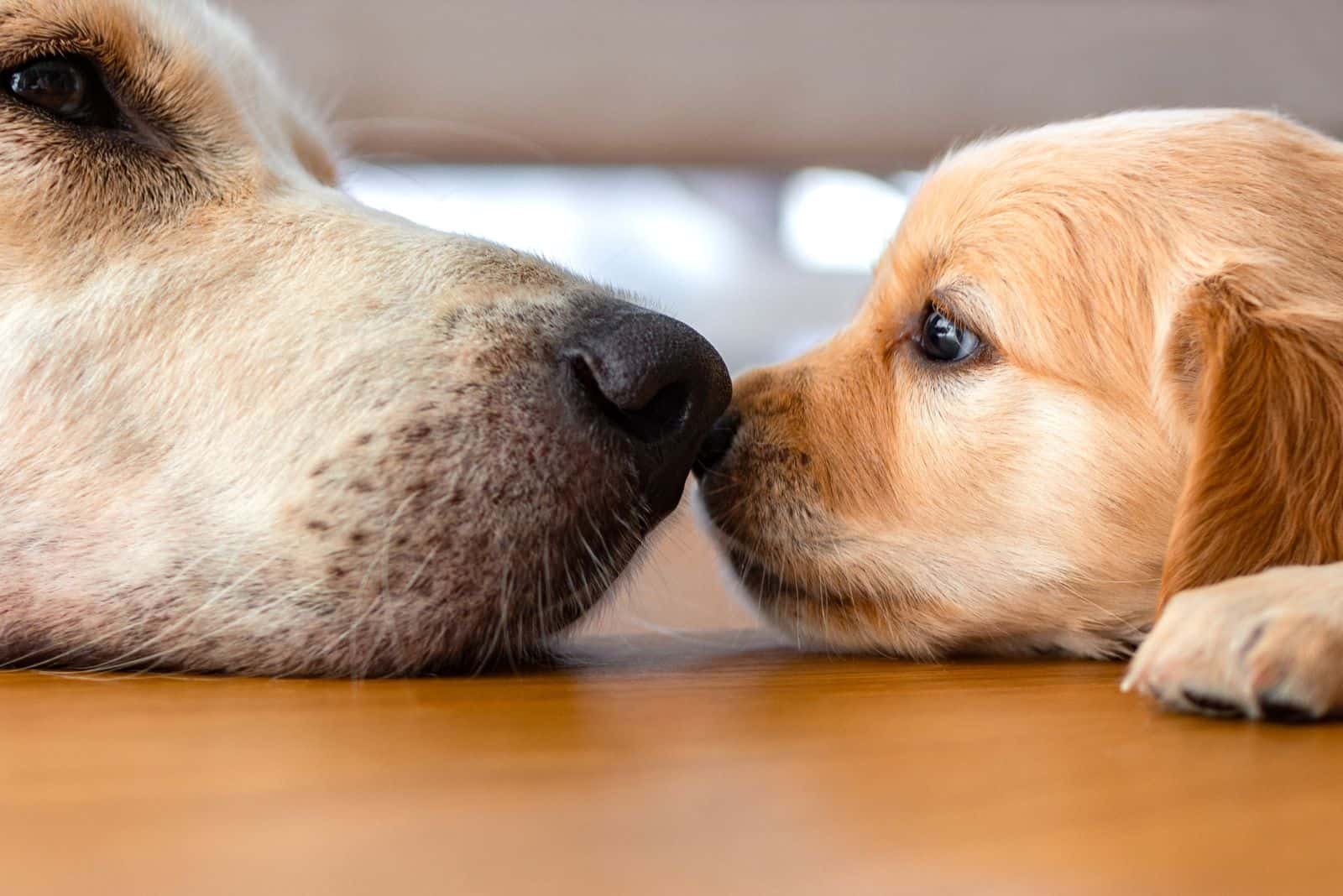
When winter comes, the entire family sits around the warmest spot in the house. Radiators and heat vents make the humidity evaporate from the air, thus creating the ideal conditions for a dry nose.
Dogs do not walk around thinking they will have a dry nose if they lie next to the heater. In their world, body warmth takes precedence over a potentially dry nose. That warmth might create grooves and cracks in the dog’s nose if the dog spends a lot of time around the warm air.
Get a humidifier, or put some wet towels on the heater or radiator to get some of that moisture back into the air. Alternatively, put the dog’s bed in a spot where warmth is trapped but not produced in its proximity.
4. Allergic Reaction
Dogs and humans are not that dissimilar in terms of what bothers us in our daily lives. Allergies are certainly a possible answer to why your dog has dry skin on its nose. There are many things a dog can be allergic to — dust mites, food, mold, pollen, etc.
Certain dog breeds, like French Bulldogs, Pugs, and brachycephalic breeds in general, are more prone to airway and skin problems, such as this one. Brachycephaly is a condition of a shortened nasal passage in addition to other shortened anatomical facial features.
With an anatomically unsound airway, reverse sneezing or paroxysmal respiration can be quite detrimental in brachycephalic breeds. Allergens inhaled into the lungs can cause problems that go beyond the airway.
Cutaneous (skin) symptoms that are associated with allergic reactions include a dry nose and thickening of nose skin (nasal hyperkeratosis). The skin is affected because the immune system alerts the body that there are foreign bodies in the bloodstream.
Once the antigens are dispatched to deal with the intrusion, inflammation can occur in one of the blood vessels of the skin on the nose, reducing the amount of moisture that the skin naturally has.
Non-steroid anti-inflammatory medication is usually prescribed in addition to removing or minimizing exposure to allergens.
You might be tempted to put some vaseline on your dog’s nose to give the skin nourishment, but I would avoid it as the dog will lick it off and potentially have stomach issues.
5. Dry Eyes Cause Dry Nose
It seems strange when you read it for the first time, but dry eyes really do make the nose go dry. The reason behind it is that the nose’s moisture is efficiently provided by the tear glands. The tear duct connects to another duct that circulates through the nose and goes back into the sinuses.
Qualitative or quantitative dry eye causes the tears to either evaporate too quickly or are not produced in large enough amounts, respectively. If the tears cannot reach or are not plenty enough, the wet nose will become a crusty dog nose.
The treatment options include artificial tears or creams that keep the eye lubricated to avoid cornea damage or ulcers. The rarer condition, qualitative dry eye, sometimes needs to be corrected by doing surgery that connects the salivary gland to the tear duct.
6. Nasal Hyperkeratosis
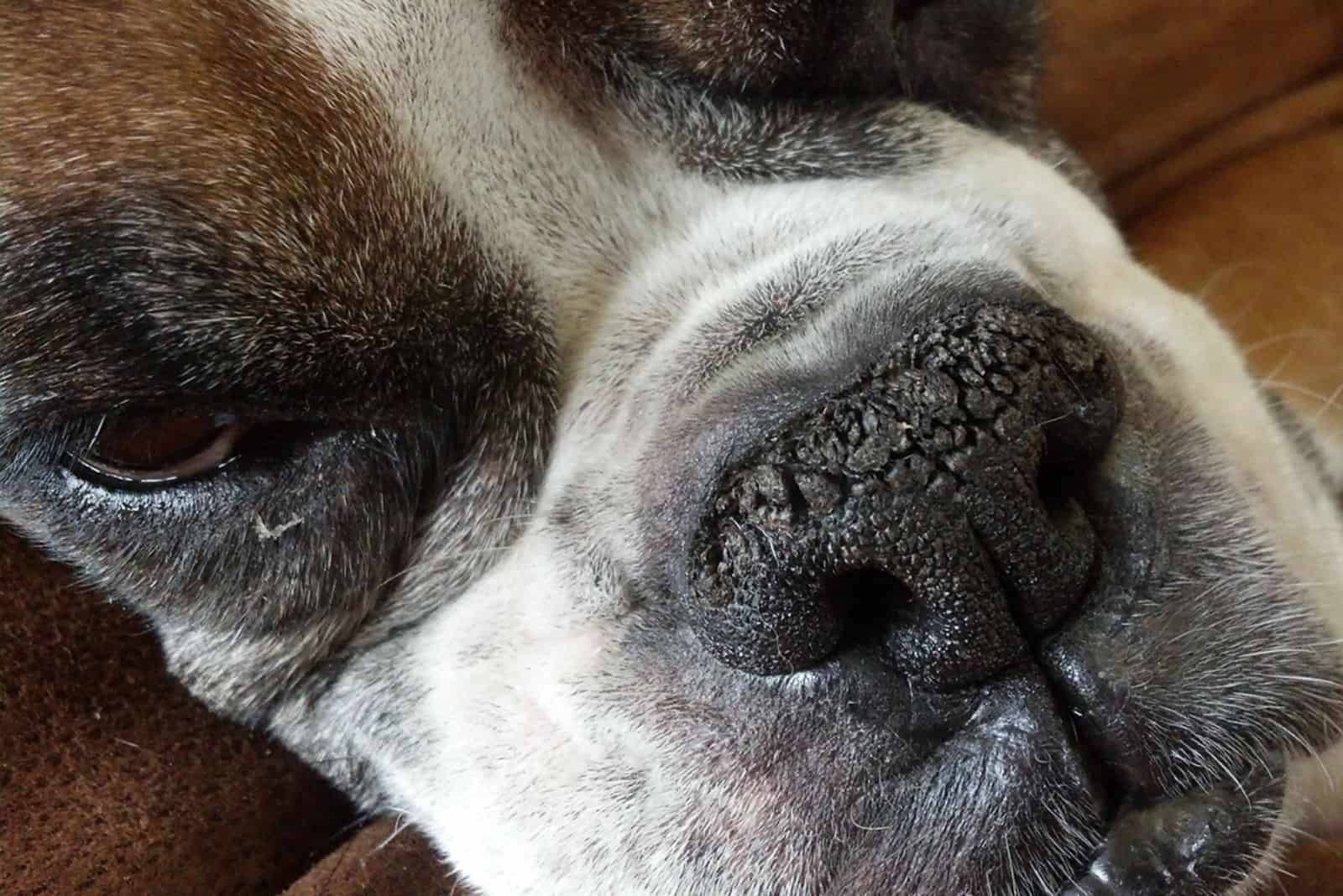
Hyperkeratosis is both a symptom and a cause. Essentially, it is a buildup of keratin in the layers of the dog’s skin. This buildup causes the epithelium to thicken, creating cracks and grooves on the nose as the keratin stacks up.
Nasal hyperkeratosis can be idiopathic in nature, which means that the causes are often unknown. In many cases, it is not a life-threatening condition and usually does not cause pain unless your dog develops a severe case (infection).
The condition can also be a symptom of an underlying health problem. Pemphigus, distemper, autoimmune, and leishmaniasis are among the most common causes of nasal hyperkeratosis.
Brachycephalic breeds and retrievers do suffer from nasal hyperkeratosis more often than other dog breeds.
7. Bacterial Infection (Mucocutaneous pyoderma)
Dogs do not really “tread carefully” when playing or running. There is no place for safety when energy is being released from a dog’s body, so tiny injuries to the nose are possible.
While in most cases, these heal on their own and go unnoticed, in some cases, the staphylococcus normally present on all skin surfaces on a dog’s body goes into overgrowth due to a weakened immune system or skin ph balance.
The progression of symptoms goes from swelling and redness to crusty skin, fissures, and loss of tissue. It is possible that a fungal infection is at work instead of a bacterial one because many of the symptoms are the same for both.
If your dog is anything like mine, digging the ground with his nose can be how the nose got infected. However, fungi like the one that causes mucocutaneous pyoderma are rarely found in backyards.
8. Pemphigus Foliaceus Is Not As Bad As You Think
An autoimmune disease that makes the T-cells think that the links between skin cells are foreign bodies is called pemphigus. There are three types according to the origin of the disease: internal, external, and idiopathic.
Internal causes indicate that the condition was congenital, meaning it was genetic and inherited from the dog’s parent(s). External means that some stimuli from the environment caused the onset of pemphigus — prolonged allergy exposure, UV light, vaccine reactions, etc.
As we already established, idiopathic conditions do not have a known cause, and in the majority of cases, only the symptoms can be treated due to the mysterious origin of the disease.
Pemphigus Foliaceus affects a dog’s skin and hair. The symptoms most often include scabs, sores, or ulcers on the nose. A crusty dog nose is not immediately indicative of pemphigus, but if the cracks and grooves in your dog’s nose become painful and discharge is present, go to a vet.
If not treated, it can spread to surrounding areas like the eyes, mouth, and ears. Another symptom that, more often than not, goes hand in hand with pemphigus is hair loss.
The combination of this and the appearance of a crusty nose are probably going to warrant a visit to the vet. Your dog might have itchy skin as a symptom, too, so be on the lookout for incessant scratching.
A skin biopsy is the best way for your vet to determine whether it is pemphigus. Taking a piece of the affected tissues and running laboratory tests alongside a look through the microscope will confirm or dismiss the diagnosis.
9. Distemper Is Not Pretty
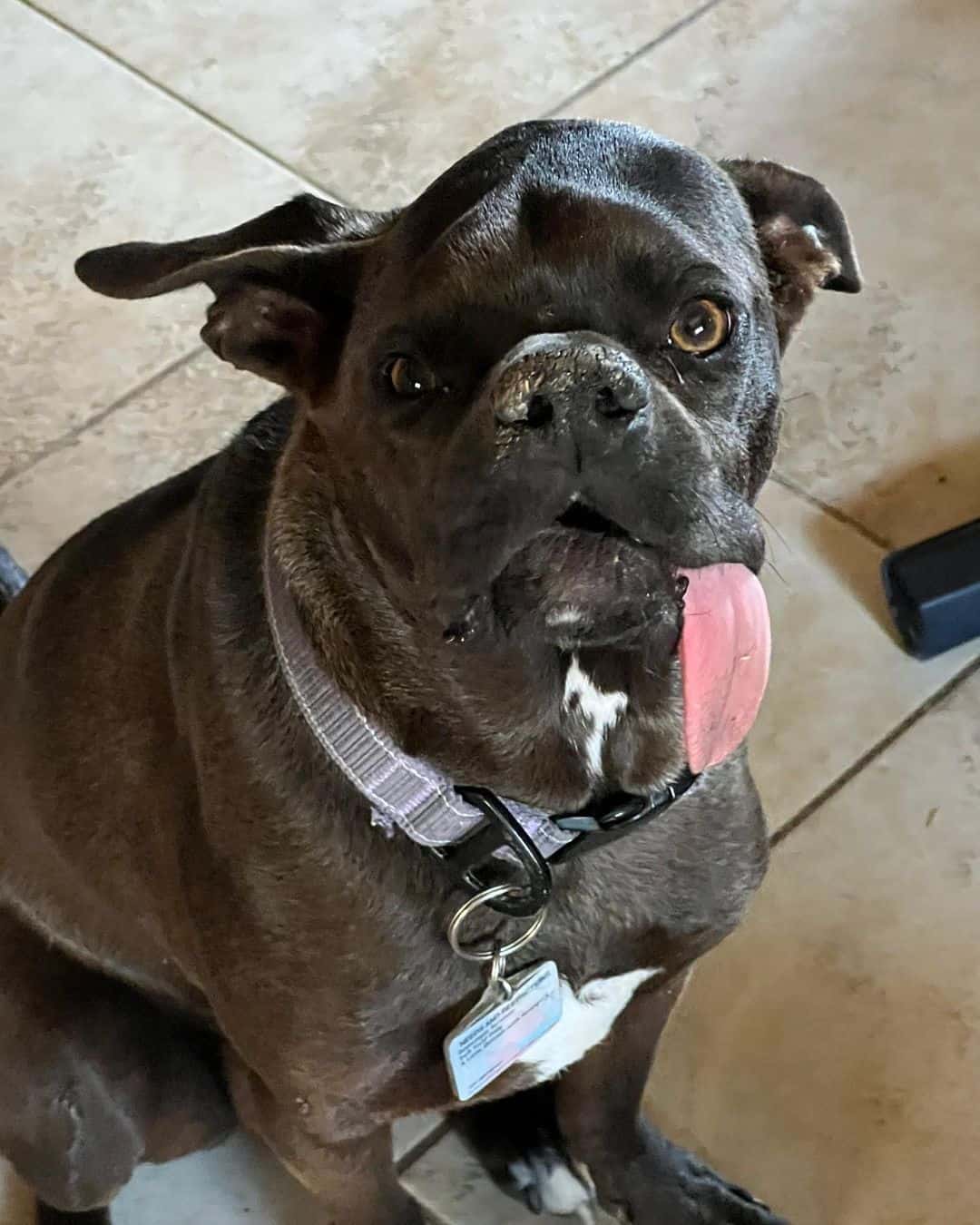
If you have a puppy, you will be reading this attentively. Good news first, though. There is a vaccine for distemper that is usually given to puppies older than four months. Clearly, skipping this vaccine is not something I would advise if you have a dog because adults can be infected too.
Areas that have wildlife, such as foxes, raccoons, and wild dogs, can put your canine companion at risk. The virus is spread through saliva, air, or feces. Simply sniffing around the spot where an animal with distemper has been can be dangerous.
While there are lots of symptoms, one that appears in most cases of distemper is the thickening of paw pads. The leathery tissue on the paw pads has an anatomy that is almost identical to that of the dog’s nose, so the symptom is present on the nose too.
A crusty nose accompanied by discharge from the eyes and nose, vomiting, loss of appetite, and fever can mean your dog has contracted distemper. If you notice your dog has become lethargic with the onset of these symptoms, definitely rush to the vet.
Many crucial organ systems suffer the consequences of distemper. Other than the skin and mucous membranes, the central nervous system (CNS) is a frequent target in cases that are not treated immediately.
Symptoms related to the CNS include excessive drooling, loss of motor function, spasms, and circling behavior. Failing to notice these symptoms on time can cause serious and permanent damage to the dog’s nervous system, resulting in a lowered quality of life.
Veterinarians usually diagnose it by performing a bunch of lab tests after visually assessing the dog’s condition. Mild cases that are caught early result in a great prognosis, while more advanced ones can be fatal.
Distemper is incurable, and symptom management is the only available treatment option. This includes reducing inflammation, preventing diarrhea and vomiting, and adapting to the dog’s needs accordingly.
10. Beware Of Leishmaniasis
Parasites are nobody’s favorite for a good reason. They do what they can to survive and, in the process, cause harm to our dogs and us. Leishmaniasis is transmitted by sand flies. A fly will get thirsty, visit a pond, lake, river, or swamp and drink some water.
Unknowingly, it will ingest the protozoan parasite from the water and spread it by biting other animals, such as critters, dogs, cats, cattle, and humans too. All the eggs laid by the sand fly will be infected by the parasite.
While the disease does infect the skin (cutaneous Leishmaniasis), it can also infect internal organs (visceral Leishmaniasis). The cutaneous type causes paw pad and nasal hyperkeratosis (nasodigital hyperkeratosis), while the visceral is much more dangerous because it leads to kidney failure.
Advancement of the disease can make your dog’s nose, and skin in general, lose pigment. The coat quality will deteriorate to the point that the hair has the appearance of a painting brush hair. Dogs with leishmaniasis lose a lot of hair, so that should be an obvious warning sign.
Treatment And Prognosis
Again, the treatment includes only symptom management, and dogs that are past the second phase of the disease are bound to develop the visceral type if they previously only had cutaneous leishmaniasis.
The second phase can be detected in the bloodwork, with nosebleeds, anemia, weight loss, and all of the other symptoms mentioned above. If your dog has enlarged lymph nodes, then that is phase three, and it most commonly leads to kidney failure.
Survival chances are not great in dogs with leishmaniasis. The disease is aggressive, and even if the symptoms are managed properly, it can intensify at any point in time.
Your dog will have to be on antibiotics if the damaged skin is prone to bacterial infections, and reduced quality of life means special secondary care for the dog’s entire life.
Keep in mind that leishmaniasis can infect humans too. Keep your dog safe by choosing your trip destinations carefully. Central and South America, Mexico, Oklahoma, Ohio, and Texas are the closest locations with reports of leishmaniasis, so practice caution.
Enough With The Disease
It got rather grim by the end there. Many of these conditions are rare, and your dog’s chances of contracting them are slim. Still, it is best to think ahead instead of regretting being leisurely about dog health.
As owners, it is our duty and responsibility to protect our dogs from danger. Although the danger, and danger zone, might be invisible to the naked eye, precaution is essential. Avoid visiting forests that have wildlife and soil rich in bacteria.
Know about the dogs you let your canine friend play with — some of them might not be vaccinated against distemper. Practice good eating habits, and check the nose for food traces. Position the dog’s bed so that the heat does not dry out the nose.
Use sunscreen to protect the skin from UV light, and do not take long walks in the winter if your dog is a brachycephalic breed or is just sensitive to cold.
Finally, that crusty dog nose you are worried sick about right now might just be the way it is. Nothing wrong with a dry nose. There are cases of dogs with perfectly wet noses that have conditions and dogs with dry noses that are as healthy as a horse.Do not panic, but always contact your vet if you notice unusual behavior or symptoms. I hope your dog’s nose stays healthy and unique. Until the next one.













